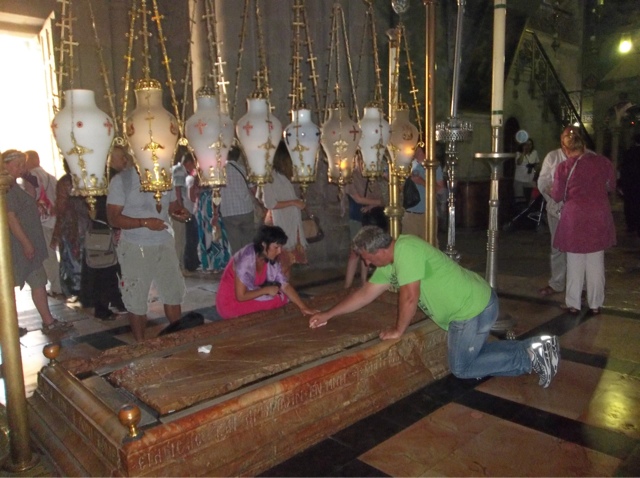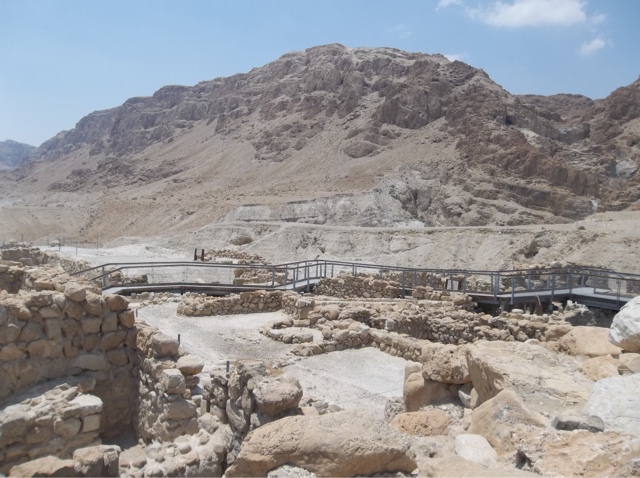Upon arriving, we headed immediately to see the Dead Sea Scrolls.
As mentioned in a previous post, these scrolls were found at Qumran in 1947 by Bedouin goat herders who threw a stone into a cave and heard pottery breaking. Inside the cave were a series of scrolls, stored in clay pots, covered with ancient Hebrew writing. The scrolls were sold several times before ending up in the museum. They are about 2,000 years old (they vary in age by several hundred years) and are the oldest documents containing the stories of the Hebrew Bible. All but about two books are represented among the many scrolls found in the original and surrounding caves, and they agree to a surprising degree with accounts written down hundreds of years later. The scrolls were written by the Essenes, a peaceful sect that waited for the End of Days and lived communally. Despite the terrible audioguide, it was fun to wander the room and see the various scrolls. The longest ones found were over eight meters in length - that's quite a lot of writing. And animal hides.
In the same exhibit was the Aleppo Codex, the second most ancient text.
It is so-called because its last resting place before the museum was in Aleppo, Syria. Sadly, when the state of Israel was declared, the synagogue where it was housed was burnt down. Most of the codex was saved, buts one of the holiest bits were lost and the document remains incomplete. They are still hoping that the other pieces will surface; one page fragment was carried around in a New Yorker's wallet for years after he picked it up in Aleppo in 1948, and was given to the museum after his death. We all left the exhibit a bit mesmerized and hoping that someday we would stumble upon something ancient and important.
The other exhibit that we had hoped to see was one on Herod the Great. We had visited so many of his constructions: Masada, Caesaria, Bet She'an, Jerusalem. And the exhibit was great. Herod the Great was really something: he imported the most expensive eyes to color his frescos, like the red cinnabar dye quarried in Spain. He had wines, fish sauces, and other consumables sent from around the Mediterranean and distributed among his palace so that he and his guests would dine in style. He schmoozed with Caesars and was seduced by Cleopatra. He was cruel, paranoid, shrewd, exacting, and imaginative. Much of what we know about him, including his bad reputation, is from "The Jewish War and Jewish Antiquities" by Joseohus Flavius, a Jew who worked for Rome. The copies of his works in the exhibit include a 1470 printing... That's only 15 years after the Gutenberg Bible, and Tia in immaculate condition. Anyway, he was really something. They say he was obsessed with building because he wanted to immortalized himself, and I think that he was quite successful.
Saturday evening, we were initiated into another Jewish ritual: Havdalah. This short, beautiful service welcomes the new week and often includes music and dancing. It is a celebration of opposites: man and woman, light and dark, etc. For our Havdalah service, we snuck into a beautiful garden just a block or two from our hotel. For the service, a braided candle with two intertwined wicks is burned and, after the prayers are said, is extinguished in the last liquid of a glass of wine (mostly consumed by the person leading the prayers). The candle is then removed and people dab wine on their forehead for wisdom, the back of the head/neck for health, and the pockets for money. According to Dana, a man once asked Shimon (her husband) why people only dabbed a little bit of wine on the pockets for money and Simon replied that you could use as much as you wanted. The man poured the entire glass in his pocket and, as luck would have it, won the lottery the very next week. Happy Havdalah!
Spotted: toilet paper. Or, rather, a lack of toilet paper. Be careful when using public restrooms on Shabbat! There's nobody to restock or clean the bathrooms and things get quite messy.



















































